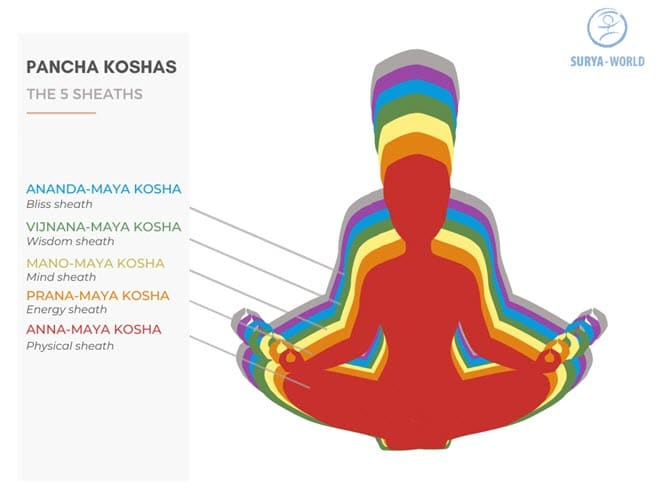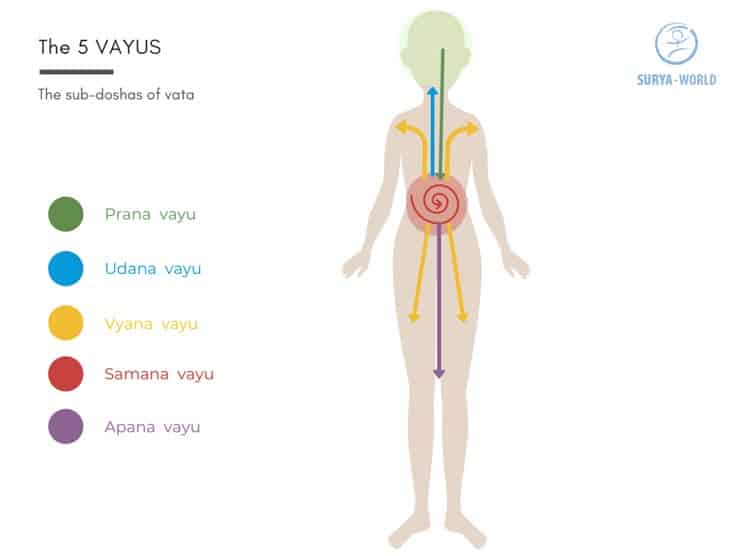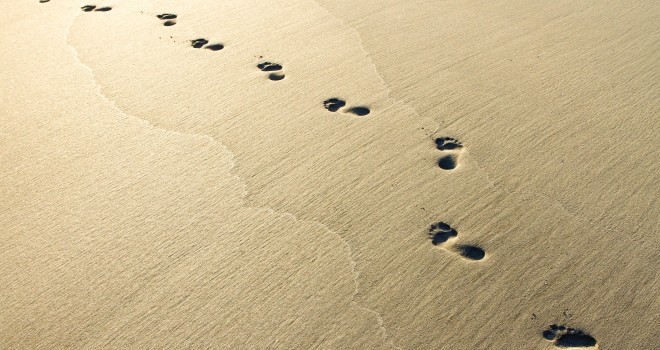WHAT IS PRANA?
Prana is a Sanskrit term meaning ‘primordial breath’ or ‘vital strength’. Prana is often linked with breath. However, it is not exclusively related to breath even if they are closely connected.
Prana is the greatest life force which sustains the spirit and operates as an intermediary between body and mind. It corresponds to the outer vital energy which can be found in nature. Thanks to the sun which is its primary source, but also through plants and food which are its secondary sources. It also refers to our own inner vital energy as an individual being, extending as far as our soul.
Original prana comes from Purusha, the energy of pure consciousness, or Self. From this prana of pure consciousness, flows the prana of creation through which the whole universe takes shape. Thus, prana is not only the fundamental vital force, it is the supreme creative and healing power coming from Pure Consciousness, or Purusha.
PRANAMAYA KOSHA, THE SHEATH OF PRANA
The human body is built around several fires. The central fire, to be found at the navel, making the extraction of prana from food and drink possible, is the digestive fire (jatharagni). The second fire of prana, situated in the heart and lungs area (pranagni), digests the prana from the air we breathe.
The sources of outer prana and their digestion nourish our energetic sheath called pranamaya kosha through the nadis (canals through which our vital energy flows). Prana can be divided into 5 sub-pranas (vayus):
- prana vayu: ‘primordial air’ ruling over inspiration and going inward,
- apana vayu: ‘air flowing down’ ruling over elimination, going outward and downward,
- samana vayu; ‘balancing air’ ruling digestion,
- udana vayu: ‘ascending air’ ruling over expiration and going upward,
- vyana vayu: ‘diffuse air’ having and expanding action.
PRANA AND BREATH
Breath, thanks to the air inhaled through our lungs and to its movement, enables us to attract prana inside our body so as to nourish our tissues and keep our cells and our body alive.
Through yogic breathing exercises (pranayama), breath is a powerful means to feed and increase the quantity and the quality of our prana (as long as the air we breathe is clean and free from pollutants and chemical particles such as pesticides). The aim of pranayama is not only to bring more oxygen to our lungs, it builds a bridge between our outer prana – linked with our body – and our inner prana – linked with the mind. It balances and harmonises our pranic energies which are scattered by our thoughts and emotions so as to gather them together. This increases our pranic strength.
This harmonisation of prana can start simply through balancing our breath between our left and right nostrils, particularly with alternate breathing (nadi shodhana). Alternate breath balances the flow of prana through the Ida and Pingala nadis (lunar and solar energies) as well as the 5 vayus (prana, apana, samana, udana, vyana), and to concentrate them so as to get in touch with our inner prana, at the level of our consciousness. Thus, when the breath is well balanced, we can get in touch with our inner prana and access meditative states more easily.
HOW TO POSITIVELY INFLUENCE YOUR PRANA?
All ayurvedic treatment methods, from nutrition to plants, as well as massages and meditation are ways to positively influence prana.
- Food is the important pranic vehicle. The energy obtained with it is the deepest (as long as it is fresh, cultivated away from pollution and pesticides and in respect with nature).
- Plants and their soma (their sap, a nectar having some powerful vital essence) also are an important source of prana. They operate at a subtler level than food; they increase the flow of prana in nadis, enhance the correct flow of the five sub-pranas (vayus), and regulate their functions such as digestions, elimination and perspiration.
- The prana which is transmitted through touch with massages, can remove pranic blocks from the muscles and bones.
- Yoga asanas, balances and stimulates the flow of prana, removing the obstructions causing physical and emotional tensions. The practice of sun salutations, during which we bow to the rising sun, is in fact a prayer to the sun, which is the first and foremost source of the prana on earth which we get through its rays and which produces this vital energy.
- Yoga pranayama, balances and stimulates the flow of prana in the body, and develops pranagni, the agni of the prana responsible for the transformation of the oxygen from outer air into inner vitality strength, so as to purify prana and stimulate its flow in the nadis.
- Meditation, by controlling the activity of our mind and senses, creates some space in the mind so as to increase and concentrate prana, making it possible for us to connect with our inner prana.
Article based on the teachings of Dr. David Frawley
- Yoga & Ayurveda – Self-Healing and Self-Realisation (book)
- Ayurvedic Healing (book)
- Prana, a short lecture by Dr David Frawley (audio recording)

Pranamaya kosha refers to the organs of action (the 5 karmendriyas), and to desires such as hunger, thirst, reproduction and emotions. This sheath also operates as a link between the physical body (annamaya kosha) and the three sheaths linked with mind (manomaya kosha, vijnanamaya kosha and anandamaya kosha), it is thus also closely related to our mind as well. Pranamaya kosha is thus not the source of prana, but the intermediary between body and spirit. The highest form of Prana is to be found at the level of our individual soul and outlives our physical life. It is connected with happiness and bliss (ananda), divine love, devotion and compassion. It comes from knowledge (vijnanamaya kosha), transcends the senses (manomaya kosha) and acts through anandamaya kosha, the sheath of divine love and bliss.
This means that all the sources of outer prana sustain an inner prana which goes way deeper, and which origin is the divine consciousness at the centre of our Being. This core of spiritual prana goes beyond breath and persists continuously even after death.





